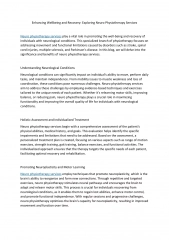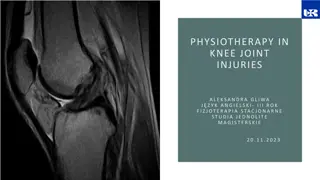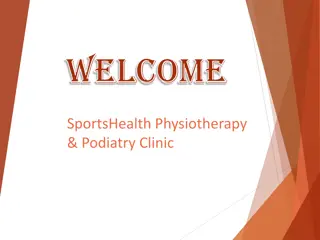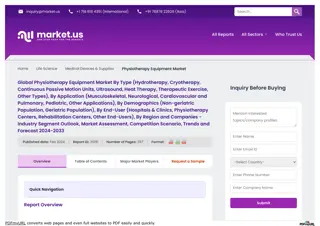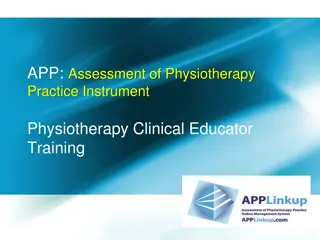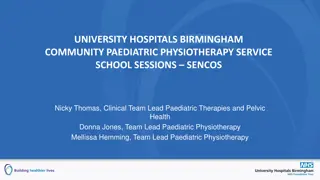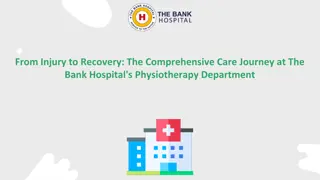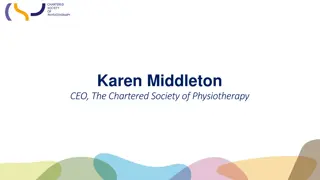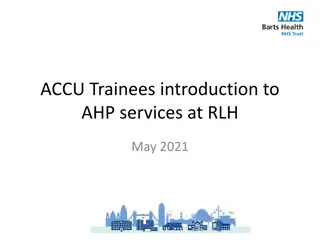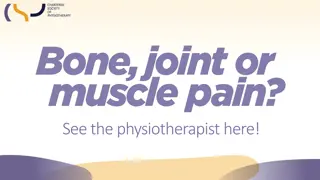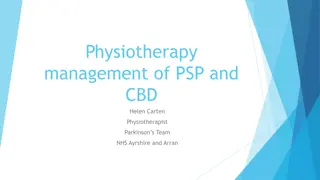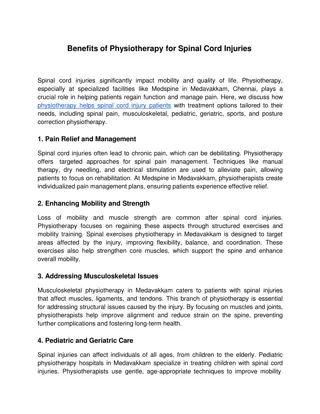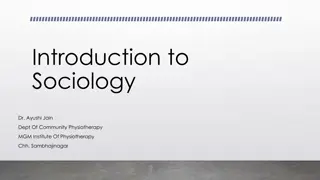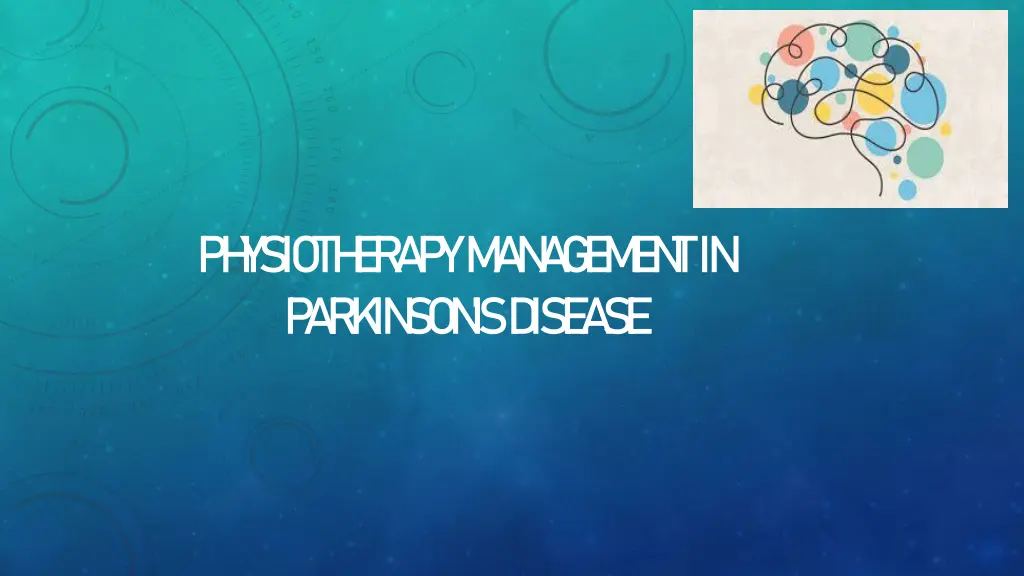
Parkinson's Disease Management Overview
Explore the pathophysiology, clinical features, causes, and symptoms of Parkinson's disease. Learn about tremors, postural instability, stooped posture, and sensory issues associated with the condition. Understand the impact on speech, voice, and swallowing in individuals with Parkinson's disease.
Download Presentation

Please find below an Image/Link to download the presentation.
The content on the website is provided AS IS for your information and personal use only. It may not be sold, licensed, or shared on other websites without obtaining consent from the author. If you encounter any issues during the download, it is possible that the publisher has removed the file from their server.
You are allowed to download the files provided on this website for personal or commercial use, subject to the condition that they are used lawfully. All files are the property of their respective owners.
The content on the website is provided AS IS for your information and personal use only. It may not be sold, licensed, or shared on other websites without obtaining consent from the author.
E N D
Presentation Transcript
PH YSIOTH E R A PY M A N A G E M E N T IN P A RK IN SON S D ISE A SE
PATHOPHYSIOLOGY: Antipsychotic drugs, encephalitis and other causes . Affects substantia nigra , destruction of dopamine producing neurons within the basal ganglia. Reduces amount of striatal dopamine ( inhibitory effects) Increase in Ach (excitatory effects of increased Ach) Difficulty in controlling and initiating voluntary movements
PARKINSONS DISEASE DEFINITION: chronic and progressive degenerative disorder that primarily affcets the neurons of the basal ganglia. CLINICAL FEATURES: Be- Bending forward S- Shuffling gait M- Mask face A- Akinesia R- Rigidity T- Tremors
CAUSES: Heredity Antipsychotic drugs ( or neuroleptic agents) Encephalitis infection in response to braintrauma, tumors, hydrocephalus or ischaemia Neurotoxins such as cyanide, manganese and carbon monoxide Drugs toxicity Idiopathic parkinsonism Secondary parkinsonism Parkinson Plus syndromes
TREMORS: Involuntary osscilation of body Resting tremors Pill rolling tremors Jaw, tongue and forearm Postural tremors POSTURAL INSTABILITY: Narrow BOS Increase attentional demand causes postural instability Icrease difficulty in walking, turning and functional reach outs Rigity present but reduced muscle torque and reduce ROM
STOOPED POSTURE: due to increased weakness in trunk extensors and overactive flexors, results in increased thoracic kyphosis, flexed cervical spine. Plantar flexors contracture leades to more instability HYPOMIMIA MICROGRAPHIA START HESITATION FREEZING OF GAIT Increases risk of falls.
SENSATIONS: 50% people have paraesthesia, pain, numbness, tingling, coldness, aching pain and burning. Akathisia inner restlessness and need to move. Proprioception is affected SPEECH, VOICE AND SWALLOWING: Chocking and aspiration pneumonia Sialorrhea- drooling of saliva due to inability in swaloowing HYPOKINETIC DYSARTHRIA- reduced volume, monotone/monopitch speech. Houarse and breathy voice Advanced cases of PD show mutism.
COGNITIVE : Dementia- visuospatial skills, memory, verbal fluency Bradyphrenia- slowing of thoughts and information processing Problems with selective attention Hallucinations and delusions L-dopa toxicity Depression is common ANS: Dysautonomia: thermoregulatory dysfunctions, seborrhea and seborrheic dermatitis Slow pupillary response to light and pain, GI dysfunction: poor motility, changes in appetite, sialorrhea, constipation and weight loss. Urinary bladder dysfunction such as urinary frequency, urgency, urge incontinence and nocturia. Sexual dysfunctions
CARDIOPULMONARY FUNCTION: Orthostatic hypotension, low resting blood pressure, compromised CV reflexes, cardiac arrythmias, airway obstruction, lower VT, FEV and high residual volume. Venous pooling in lower extremities.
GOALS OF PHYSIOTHERAPY MANAGEMENT : Patient/client, family and caregiver knowledge and awareness, prognosis and plan of care Decrease pain, Improve motor function Improve muscle performance Improve postural control and balance Improve gait and locomotion Manage fatigue Increase aerobic capacity Energy conservation skills Increase independence in ADLs
PHYSIOTHERAPY INTERVENTION: MOTOR LEARNING STATEGIES- Large number of repetitions for skill development Random practice to avoid Clutter free environment to avoid freezing Structures instructions to be given Cues such as visual, verbal, rhythmic auditory stimulation, pulsed cues and multisensory cueing, facilitate movement by using different brain areas.
RELAXATION EXERCISES: Gentle rocking to produce relaxation PNF technique of rhythmic initiation Relaxation audio tapes Gentle yoga and Tai chi Lifestyle modification and time management techniques
Flexibility exercises: Emphasis on active ROM exercises ROM exercises in physiological patterns of movement Traditional stretching Passive positioning to correct pillow posture Mechanical stretch using tilt table STRENGHTENING EXERCISE: Progressive resisted exercise regime to be followed based on individual muscle strength, muscle endurance can be increased using rhythmic therapies such as bicycle ergometry.
FUNCTIONAL TRAINING: Mobility in bed Exercises in sitting to improve pelvic mobility Sit to stand transitions Standing traing Functional training to get up from a fall Mobilisinf facial muscle Correcting dysphagia via- tongue execises and tongue pull manouvre, shakers exercise etc Verbal skill practise with breath control
BALANCE TRAINING: Emphasise more on dynamic mobility task Seated activities on swiss ball Functional reach out and spot marching Heal rises and toe off in standing, partial wall squats and chair raises Single leg stance with side kicks and back kicks Kitchen sink exercises
GAIT TRAINING : Training designed to lenghthen stride, broaden BOS, improve stepping, improve heel-toe gait, increase contralateral trunk movement and arm swing, increase speed, regulate regular walking. Hurdle walking can be helpful in overcoming the problem of freezing. Cardiopulmonary : diaphragmatic breathing exercises , diaphragm and intercoastal stretch and inclusion of aerobic exercises. PNF

